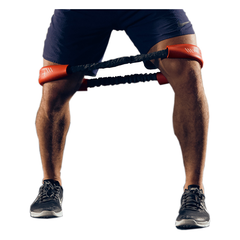This year, I’ve embarked on a running plan with some strength work geared toward running. That includes lots of single-leg work, hamstrings, and core, plus a good amount of glute training by adding in the hip & core program.
Although, I also want my upper body to be more akin to what I imagine as the original greek marathoner than your stereotypical endurance junky.
So I’ve added some upper-body training to my program, with hypertrophy being the primary goal.
I’m not after the gains you see at a bodybuilding show, but just enough that an observer on the street would say, “He must work out.”

Then, with the time needed to run some miles and a job and a family to look after, I don’t have much extra time to commit to the gym. Plus, getting my run times down is my priority right now, and blasting my body with upper-body lifts is counter to that.
Thus, in total, I needed a program to add some upper body muscle that didn’t take up a ton of time or leave me sore for several days to follow.
Does that sound like you?
If so, here’s some evidence to steer you in the right direction for how many reps to gain muscle.
How Muscles Grow
We used to explain muscle growth as a process of breakdown and repair.
The old idea was that microscopic tears occur in your muscle fibers when you lift weights. While recovering from the workout, the body uses protein to repair these tears and build them up stronger than before―leading to larger muscles and increased strength.
But recent research shows that the “breakdown” part of this equation may be over. Instead, we only need the muscle fibers to receive enough tension, which will stimulate them to grow.
The key word there is “enough.” How many reps, sets, and sessions do we need to yield maximal gains without going overboard?
Stimulating Reps
It’s long been accepted that heavy low reps (1-5) build strength, medium reps (8-12) with moderate weight is best for muscle growth, and high reps (20+) reps with light weights are what you do for muscular endurance.
However, the current research doesn’t support this statement.
You can build muscle just as well with each of these rep schemes as long as you meet the following criteria:
- The speed was controlled enough to create tension in the muscle.
- You bank reps in a zone that’s within 5 reps of failure. These are known as stimulating reps.
Point one should be clear enough, but number two probably needs some clarification.
For example, if you do 12 curls and barely squeeze out the last one, you’ve logged 5 stimulating reps (8-12). If you march up to the squat rack and do 5 crazy heavy curls and barely get the last one done, again, you’ve done 5 stimulating reps (1-5). Or, for the last example, if you do 25 curls and finally reach failure, you’ve similarly completed 5 stimulating reps (20-25).
The evidence shows that each of these scenarios will result in the same degree of muscle gain.
Putting it all together, no matter your rep range, getting close to or hitting your max effort creates the optimal conditions for muscle growth. Conversely, leaving reps in the tank (called reps in reserve) lowers your total stimulating reps.
I highly recommend Chris Beardsley’s ebook Hypertrophy to learn more about building muscle. It’s available on Amazon for only $3.

How to Apply This?
It’s important to note that I don’t believe this means you should always go for max weight and max reps each time you lift. Instead, it’s important to understand the concept of stimulating reps and use this information to adjust your personal training plan or the plans for your clients.
If you’re an experienced weightlifter, you likely know a 5RM set of squats to failure feels much different than a 10RM set of leg extensions. Similarly, dialing up a 5-rep max bicep curl doesn’t seem practical or safe as dropping the weight and going for 8-12.
Even if the muscle growth is the same for each scenario, they do not have the recovery, psychological, and orthopedic costs.
Therefore, it all comes down to personalization and weighing your personal goals, comfort level, available equipment, pain or injury issues, and other factors.
Personally, I’ve dialed this into two additional upper-body weekly sessions that fall on days following my key runs. I first focus on “strength” using lower rep ranges (5-8) for my compound push-pull exercises, such as bench presses and pull-ups, because I want to be “strong” with these exercises regardless of hypertrophy goals in this rep range.
Then, I chase the pump. I pick various exercises primarily for the chest, biceps, triceps, and deltoids and aim for failure between 8-12 reps. In total, I aim for 6 sets, or 30 stimulating reps, on each muscle group, and I finish with the Crossover Symmetry Strength Program for my back work.
In total, it takes about 30 minutes.
The Law of Diminishing Returns
When I initially embarked on my getting swole plan, I dug up a German Volume Training Program to meet my goals. Infamously known for its crazy volume (10 sets of 10 reps is the classic template,) but after some long training sessions, I started questioning if this was all worth it.
For starters, there were a whole lot of reps that weren’t “stimulating.” But we also know about the law of diminishing returns, where doing double the work only yields marginal gains.
To be maximally efficient, I wanted to know how many sets I needed per week. I think this article by Stronger by Science sums up the research the best and comes to a conclusion that,
“You could also use the present meta-analysis to credibly argue that 12-20 sets per week are plenty, and drifting up toward 20+ sets per week is likely unnecessary.”
Simply put, it’s not about how many sets you do; it’s about doing the right amount of work to stimulate muscle growth. Experiment and listen to your body, and remember you don’t always have to go for the most extreme option.
And when it comes down to it, using a moderately heavy weight in combination with an appropriate rep range should yield muscle growth if you consistently reach or come close to failure on the last 1-3 reps.
Hopefully, this article will help dial in your training.
 Shoulder Packages
Shoulder Packages
 Hip & Core Package
Hip & Core Package
 NEW - Crossover TORQ
NEW - Crossover TORQ
 Bundles
Bundles
 Accessories
Accessories


























